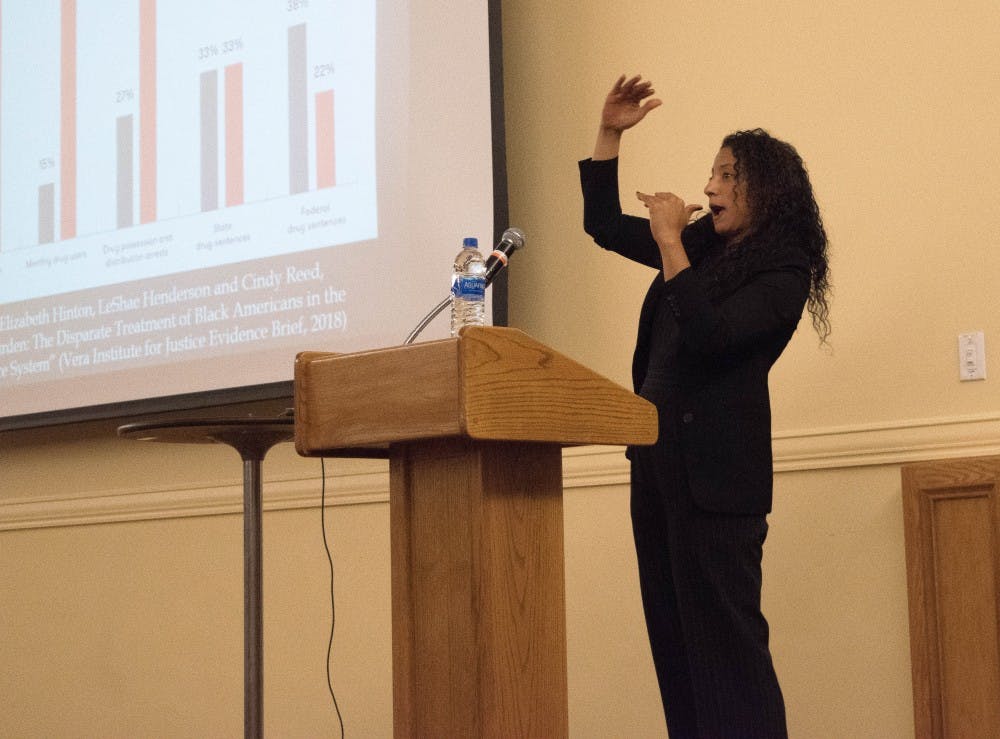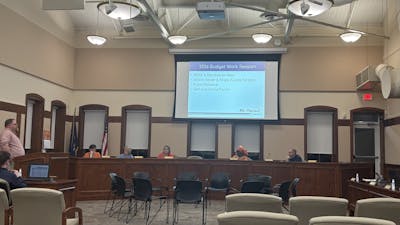Harvard professor lectures on mass incarceration in America

Dr. Elizabeth Hinton of Harvard University explains a graph at her Constitution Day Lecture in Powers Hall on Friday, Sept. 21.
Harvard University’s Dr. Elizabeth Hinton spoke about mass incarceration in America on the campus of Central Michigan University on Sept. 21.
With a full audience, Hinton spoke about past mistakes regarding prison populations in America, that we should learn from.
Hinton has been a professor at Harvard since 2014, working in the history and African and African American studies departments. In central California, she works with local law enforcement on new approaches to procedural justice.
The United States makes up five percent of the world’s population but takes up 25 percent of the world’s prison population. The prison population in the United States has increased 700 percent since 1970, Hinton said.
Hinton said this was due to the federal government acting on predictions of crimes, rather than actual crimes, which resulted in targeting racially marginalized Americans.
“The likelihood of going to prison, unless we do something to change these current policies, is one in three if you’re black,” Hinton said.
Hinton said the inequality today mirrors that of the Gilded Age, which is the 1870s to the early 1900s.
“The spirit of my work is the importance of reckoning with some of the mistakes of our past and learning from the mistakes in order to move forward," Hinton said.
Some mistakes that Hinton spoke about included the Stop the Robberies Enjoy Safe Streets (STRESS) project. This project included a unit of undercover police officers in Detroit that pose as prey "in order to better monitor potential suspects and provoke assailants,” said Hinton.
Hinton said John Nichols, Detroit police commissioner, designed STRESS in 1971 to control the lower income – mostly black neighborhoods that have been identified as the epicenter of crime.
Grand Rapids junior Kaitlin Rich said she was familiar with some of the ideas that Hinton presented, but she didn’t realize how quickly it had escalated into racial intentions.
The officers “acted on predictions of crime rather than actual crimes, or as Nichols put it ‘to predict which direction the criminal will move so we can be waiting for him’,” Hinton said.
Martin junior Lexi Walters said she thought the preemptive measures that the federal government took were interesting.
Another project, called Operation Sting, had a company called PFF Inc. – Police-FBI Fence, Incognito – officers posed as mafia members who had bought buildings to use as black markets. Here, they arrested hundreds of small-time crooks, Hinton said.
“Essentially, Operation Sting created a demand for crime by providing the crooks with a market to sell stolen goods," Hinton said. "As long as the thieves could deliver the goods, as their employer PFF Inc. provided them with a steady source of income. The officers built criminal profiles of their customers over the course of Sting and PFF agents would provoke the criminals.”
Although Operation Sting and STRESS were successful operations, they encouraged people to commit crimes, which resulted in many arrests. Hinton said these operations could be considered entrapment, which is the use of overbearing tactics to coerce someone to commit a crime.
“I think what my work proves is that the decision to invest hundreds of billions of dollars into policing surveillance and incarceration has not necessarily worked to improve safety in our communities and has exacerbated inequalities in our society," Hinton said. "We are in a moment where we really need to try new approaches to fundamental social problems."






